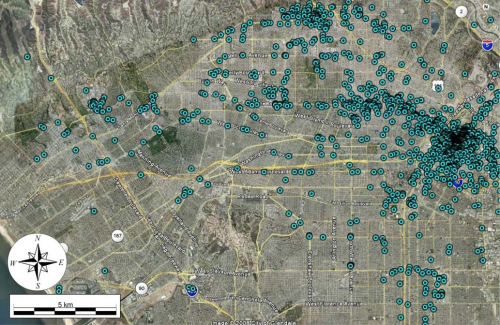Study identifies quake-prone concrete buildings in Los Angeles area

Researchers in the National Science Foundation's George E. Brown Jr. Network for Earthquake Engineering Simulation have identified concrete buildings constructed before roughly 1980 in the Los Angeles area. This category of buildings, sometimes referred to as nonductile concrete buildings, is known from experience in previous earthquakes to have the potential for catastrophic collapse during strong earthquakes.
The poor seismic performance of nonductile concrete buildings was evident in many recent earthquakes, including those in Northridge, Calif., in 1994 and Christchurch, New Zealand in 2011.
"We have learned the lesson over and over again in past earthquakes in the United States and abroad that many of our nation's older concrete buildings, where many of us live and work, are not safe during an earthquake," said Jack Moehle, T.Y. and Margaret Lin Professor of Engineering, at the University of California, Berkeley. "This project used the NSF-funded NEES laboratories around the nation to provide building owners, occupants and public officials with solutions to make these buildings safer.
"Many nonductile buildings remain standing long enough after an earthquake occurs for occupants to escape because their columns retain enough strength to support the structure. Our goal was to identify those nonductile buildings that will not remain standing, what we would call 'killer buildings.' "
Thalia Anagnos of San José State University said, "A key element of the research was to identify the number and types of older concrete buildings in a typical city. We chose the city of Los Angeles."
Along with co-investigators Mary Comerio (UC Berkeley) and Jonathan Steward from the University of California at Los Angeles, Anagnos developed a detailed inventory and conducted loss studies to identify the scale of the problem and the impact of mitigation strategies on reducing losses.
In January the researchers provided Los Angeles officials the addresses of about 1,500 older concrete buildings within the city. The inventory includes residential, commercial and critical service facilities such as hospitals. They estimate that about 5 percent of these buildings may have a high risk of collapse.
Nonductile concrete buildings were a prevalent construction type in seismically active zones of the nation before enforcement of codes for ductile concrete were introduced in the mid-1970s. A companion study performed in partnership with the Earthquake Engineering Research Institute and the Concrete Coalition estimate that approximately 17,000 nonductile reinforced concrete buildings are located in the most highly seismic areas of California.
"Given the large number of older concrete buildings, it is not economically possible to strength every one," Moehle said. "Instead, our research is developing engineering tools to identify the most dangerous buildings within the inventory."
Findings and mathematical modeling tools developed in the project could be applied to mitigation programs in other seismically active regions of the world. More than 75 million Americans in 39 states live in towns and cities at risk for earthquake devastation.
Provided by Network for Earthquake Engineering Simulation


















